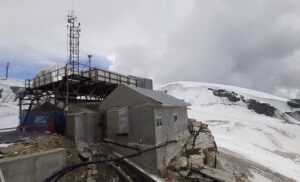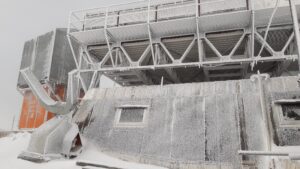The high altitude Testa Grigia Observatory is located in the western Italian Alps, at Plateau Rosà in the Matterhorn group. It plays a strategic role for the observation and study of climate-environmental processes. The Department has been responsible of the scientific and logistical management of the station since 2019.
The parameters continuously monitored at the Observatory include:

View of the Test Grigia Observatory from the arrival of the cable car that connects “Cime Bianche Laghi” to “Plateau Rosa” at 3480 m asl. The aluminum shelter hosts two bedrooms, a living room, and a small kitchen, while the rear of the Observatory host the scientific laboratories.
- Aerosol size distribution (National Research Council: ISAC Institute of Atmospheric Sciences – ISP Institute of Polar Sciences)
- Carbon dioxide and methane (RSE Ricerca di Sistema Energetico)
- Cosmic radiation (INFN National Institute of Nuclear Physics)
History of the Observatory
The Observatory was inaugurated on the 11 of January 1948, under the scientific direction of Gilberto Bernardini and Ettore Pancini that, with Marcello Conversi, Edoardo Amaldi, Enrico Fermi and other physicists, realized the infrastructure for the study of cosmic rays. The creation of the Observatory was also supported by a few private companies. Historical records of the INFN of Turin (National Institute of Nuclear Physics) confirms that the main Italian automotive company “Fiat” was “..interested in the basic research and peaceful use of nuclear energy “ and participated with the CNR to the construction of the laboratory. Considering the pioneering work of that time, and the location that allows to study the background atmosphere, the observatory is a place full of history and of great scientific value.
Since 1989 the CNR has been hosting the activities of RSE – Ricerca di Sistema Energetico (formerly CESI – Centro Elettrotecnico Sperimentale Italiano) which started the monitoring of carbon dioxide and other greenhouse gases. The site became first one of the regional stations of the Global Atmospheric Watch program of the World Meteorological Organization, GAW-WMO and now it is included in the European program ESFRI-ICOS, Integrated Carbon Observation System.

View of the Test Grigia Observatory from the ski track that connects Testa Grigia to Cervinia and Zermat.
INAF – National Institute of Astrophysics and INFN – National Institute of Nuclear Physics continued the monitoring of cosmic ray flow and the study of the South Atlantic Magnetic Anomaly (SAA, South Atlantic Anomaly). The site is mainly devoted to the measurement of the dose of secondary cosmic ray neutrons.
The observations continued in the following decades and the National Research Council started atmospheric observations, including measurements of tropospheric ozone. From 2019 the Department of Earth System Sciences and Technologies for the Environment – DSSTTA is responsible of the Observatory management.
Present activities
Since taking charge of the station, the Department assigned the technical and scientific responsibility of the Observatory to Eros Mariani and Paolo Bonasoni, respectively. The research staff of the Department restarted their observational activities with real-time measurements of atmospheric aerosol size distribution, aerosol absorption coefficient at seven wavelengths, and equivalent black carbon concentration. These measures will allow to collect important information concerning climate change and air quality, considering that aerosol and black carbon are climate-forcers able to affect the Earth radiation budget. In addition, when light absorbing aerosols and BC are deposited on glaciers, they can promote the absorption of solar radiation, and as a “heating blanket”, increase melting of glaciers and snow areas.

